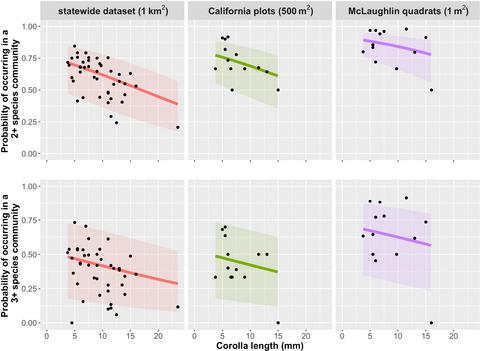Our official English website, www.x-mol.net, welcomes your
feedback! (Note: you will need to create a separate account there.)
Co-occurrence patterns at four spatial scales implicate reproductive processes in shaping community assembly in clovers
Journal of Ecology ( IF 5.3 ) Pub Date : 2021-09-04 , DOI: 10.1111/1365-2745.13776 Kyle Christie 1, 2 , Susan P. Harrison 2, 3 , Maren L. Friesen 4, 5 , Sharon Y. Strauss 1, 2
中文翻译:

四个空间尺度的共现模式暗示了在塑造三叶草群落组装中的生殖过程
更新日期:2021-09-04
Journal of Ecology ( IF 5.3 ) Pub Date : 2021-09-04 , DOI: 10.1111/1365-2745.13776 Kyle Christie 1, 2 , Susan P. Harrison 2, 3 , Maren L. Friesen 4, 5 , Sharon Y. Strauss 1, 2
Affiliation

|
- Competition, niche differences and chance all contribute to community assembly; yet, the role of reproductive interactions between species is often less appreciated. Closely related plant species that share floral form, phenology and habitat often interact through pollination. They potentially facilitate pollinator attraction, compete for pollination services and/or exchange pollen. If reproductive processes are important to co-occurrence, we predicted that fitness costs of heterospecific pollen transfer or pollen limitation should result in lower rates of co-occurrence among outcrossing congeners. In contrast, selfers, which may be less exposed to heterospecific pollen, and/or less negatively affected by it, should co-occur more frequently.
- Flower size is an excellent proxy for mating system in clovers. Using herbarium records and three independent field datasets, we documented co-occurrence patterns of Trifolium at 1 m2–1 km2 scales in California. Using a randomization procedure to reshuffle matrices of community membership, we generated null hypotheses for the expected composition of large- and small-flowered species in Trifolium communities of different sizes.
- Across all spatial scales, large-flowered outcrossers were over-represented at sites lacking congeners, but under-represented in communities with multiple congeners. Conversely, small-flowered selfers often occupied sites with multiple other Trifolium species. Patterns for plant height and leaf size, which are weakly or strongly correlated with flower size, did not explain co-occurrence patterns as robustly. Regression analysis and model selection corroborated the null model analyses, indicating that the likelihood of co-occurrence decreased as flower size, and thus reliance on outcrossing, increased.
- Synthesis. This study suggests that reproductive traits and processes may be significant contributors to community assembly and co-occurrence in flowering plants.
中文翻译:

四个空间尺度的共现模式暗示了在塑造三叶草群落组装中的生殖过程
- 竞争、利基差异和机会都有助于社区集会;然而,物种之间繁殖相互作用的作用往往不被重视。共享花型、物候和栖息地的密切相关的植物物种通常通过授粉相互作用。它们有可能促进传粉媒介的吸引、竞争传粉服务和/或交换花粉。如果生殖过程对共现很重要,我们预测异种花粉转移或花粉限制的适应度成本应导致异交同源物的共现率降低。相比之下,可能较少接触异种花粉和/或受其负面影响较小的自交者应该更频繁地同时发生。
- 花的大小是三叶草交配系统的绝佳代表。使用植物标本馆记录和三个独立的野外数据集,我们记录了加利福尼亚州1 m 2 –1 km 2尺度下三叶草的共生模式。使用随机化程序重新排列群落成员矩阵,我们为不同大小的三叶草群落中大花和小花物种的预期组成生成了无效假设。
- 在所有空间尺度上,大花异交者在缺乏同源物的地点的代表性过高,但在具有多个同源物的社区中代表性不足。相反,小花自交者经常与多种其他三叶草物种一起占据场地。植物高度和叶片大小的模式与花的大小弱或强相关,并不能有力地解释共生模式。回归分析和模型选择证实了无效模型分析,表明共现的可能性随着花的大小而降低,因此对异交的依赖增加。
- 合成。这项研究表明,生殖特性和过程可能是开花植物群落组装和共生的重要因素。











































 京公网安备 11010802027423号
京公网安备 11010802027423号